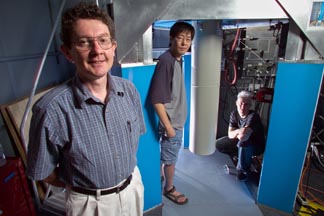Researchers identify location of crucial atoms and move closer to elusive goal of creating high-temperature superconductor
By Lauren Gold

With an advanced imaging technique and a savvy strategy, researchers at Cornell University's Laboratory of Atomic and Solid State Physics (LAASP) have shown how adding charge-carrying atoms like oxygen to a superconductor can increase the material's ability to conduct electricity overall and -- paradoxically -- to decrease it in localized spots.
The discovery, published in the Aug. 12 issue of Science, could lead to the eventual development of more effective superconductors.
The scientists, led by Cornell professor of physics J.C. Séamus Davis, used a specialized scanning tunneling microscope (STM) in the basement of Cornell's Clark Hall for the research. They identified for the first time the locations of individual oxygen atoms within a particular superconductor's molecular structure and used that information to examine how the atoms affect current flow in their immediate vicinity. It's a small but vital step, they say, toward understanding how superconductors work.
Superconductors are materials that conduct electricity with virtually no resistance. The materials, in this case copper-based compounds (cuprates) doped with charge-carrying atoms like oxygen and cooled to extremely low temperatures, are widely used in fields from medicine to the military. But the physics behind them is still not well understood, making the ultimate goal of creating a room-temperature superconductor elusive.
Researchers have long suspected that dopant atoms -- crucial for conductivity because they attract electrons and leave the positively charged gaps that allow current to flow without resistance -- are actually counterproductive because they create electronic disorder at the atomic level. But until now, no one had been able to look closely enough at the atomic structure to confirm the correlation.
The researchers at Cornell tackled the problem by preparing samples of a cuprate superconductor doped with different concentrations of oxygen atoms. Using the STM, which can measure current in areas less than a nanometer wide -- the width of three silicon atoms -- they mapped the materials according to how well or poorly current flowed in each point on the plane. The locations of the oxygen atoms, they found, correlated with the areas of energy disorder they had already identified.
"Now we can put the dopant atoms into the image and ask, are they correlated with the electronic disorder directly?" said Davis. "When the dopants are far away, electron waves are homogeneous." When the dopant atoms are near the conducting plane, though, the waves become drastically heterogeneous, causing the superconductivity to break down.
Think of the compound's electrons as dancers moving together in a carefully choreographed production, Davis said.
"Superconductivity is made by pairing two electrons. It's like a dance -- not a waltz, but a distributed dance like a contra dance," Davis said. "If you put stones in the middle of the dance floor you disturb the pattern. And once you've destroyed all the pairs, you've destroyed the superconductivity."
But (and here the contra dance analogy breaks down a little) the stones -- in this case, the dopant atoms -- are prerequisites for the dance. So taking them out isn't an option.
"These atoms have to be working in two different ways -- one way on average and another way locally," said Kyle McElroy, a postdoctoral researcher at the University of California-Berkeley and co-author of the paper. "One of the big questions is why different cuprate families superconduct at different temperatures. There's a spread of four to five times the transition temperature. Why do these transition temperatures change so much, and what is governing that?"
Experts predict that the worldwide market for superconductors will reach $5 billion by the year 2010 from about half that in 2000 -- if growth continues linearly. But if scientists can learn to make materials that superconduct at higher temperatures, the market could skyrocket.
"This kind of information is a necessary step toward understanding first the mechanism of high temperature superconductivity and, next, how to raise the transition temperatures," said James Slezak, co-author of the paper and a graduate student in physics at Cornell.
The paper's other authors include D.H. Lee of the University of California-Berkeley, H. Eisaki of the National Institute of Advanced Industrial Science and Technology, Ibaraki, Japan, and S. Uchida of the University of Tokyo.
Media Contact
Get Cornell news delivered right to your inbox.
Subscribe